Announced in 2017, the EF 85mm F1.4L IS USM is a high-speed portrait lens for Canon’s range of EOS DSLRs. It’s the first f/1.4 version from the company for this focal length and sits alongside the EF 85mm F1.8 USM and the ultra-high speed EF85mm F1.2L II USM.
As one of the last primes before the introduction of the RF series of lenses for the EOS R mirrorless system, this pro-oriented L-series lens has a revamped external finish over the earlier models and encompasses a number advanced features. These include a 4-stop optical stabilizer and a durable design with a shock-absorbing front barrel.
Designed for high-resolution imaging, it has a complex optical construction of 14 elements arranged in 10 groups, though bear in mind that three of those elements make up the optical stabilizer. Like modern rivals, it adopts a number of high-refractive index glass and anomalous dispersion glass elements to combat axial chromatic aberration, and it features a single large-diameter glass-molded aspherical element to improve edge-to-edge contrast, particularly at wider apertures.
In addition, it has an anti-reflective ASC (Air Sphere) coating to reduce flare and ghosting, while the front and rear elements have a fluorine coating to prevent drying marks from rain and help remove smudges from fingerprints when cleaning.
Autofocus is handled by a ring-type ultrasonic focus motor (USM) that moves a small inner group ahead of the diaphragm. This supports Canon’s full-time manual focus override option, as well as dual-pixel CMOS AF tech with a compatible camera. Minimum focusing distance is a typical 0.85 m (2.79 ft) and delivers a 0.12x magnification.
Measuring 88.6 x 105.4 mm (3.5 x 4.1″) and weighing 950 grams (33.5 oz), this relatively light and compact lens is aimed squarely at professionals and keen amateurs.
Key specifications:
- 14 elements in 10 groups
- One glass-molded aspherical element
- Optical stabilizer
- Fluorine and ASC coatings
- Nine-blade circular aperture
- Ring-type USM
- Dust- and moisture-resistant
- 77 mm filter thread
- Minimum focus distance: 0.85m (2.79 ft.)
- Weight: 950 grams (33.5 oz)
Overall lens image quality
We tested the Canon EF85mm F1.4L IS USM on the 50 MP Canon EOS 5DS R, the highest-resolution DSLR in Canon’s lineup. Together the combination achieved the highest overall optical quality we’ve seen for a Canon camera and any EF-mount lens, with a DXOMARK score of 49 points. That places it just ahead of the previous best combination of the manual-focus Zeiss Apo Sonnar T* 2/135 ZE on the 50 MP Canon EOS 5DS R.
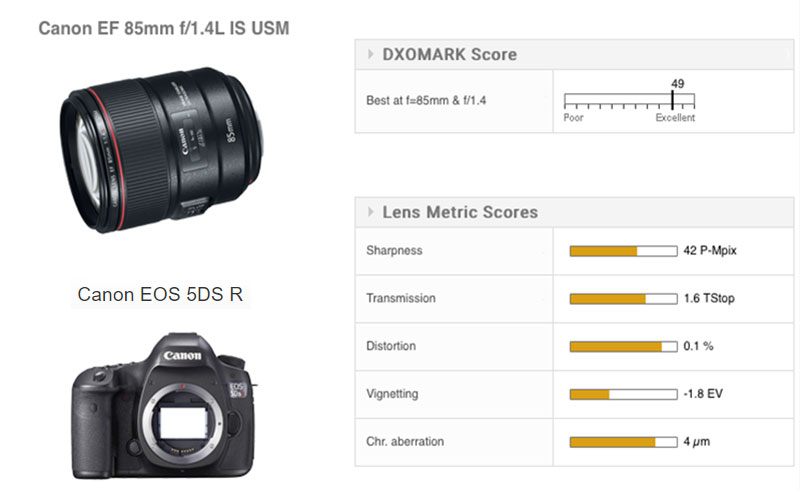
Sharpness levels are very high on the Canon EOS 5DS R, and the lens controls both lateral chromatic aberration and distortion very well. Transmission measured at T1.6 is also very good. Even vignetting when wide-open, averaged at -1.8EV, is reasonably well controlled for such a relatively compact wide-aperture lens. (We would typically expect this to be in excess of -2EV in the corners at the maximum aperture.) Overall the lens exhibits outstanding sharpness and very high overall correction of aberrations.
Image quality compared to competitors
Click here to open our interactive DXOMARK lens comparison tool.
The 85 mm focal length is very popular, as it’s generally considered to the ideal lens for indoor portraits, though some photographers like a slightly longer 100/105mm focal length. The shorter 85 mm is more often to be found in a f/1.4 version, though at one time that was rare. Of course that’s not the case now, with most manufacturers (including third-party makers) having one in their range.
Due to the proliferation of mid-tele models, we’ve highlighted only the 85 mm focal length models found in our database. As a result, this includes the slower, more accessibly priced f/1.8 models, such as Canon’s EF 85mm F1.8 USM, which still performs well, given it was made for film. The stabilized Tamron SP85mm F1.8 Di VC USD is another fine performer, though at $750 at introduction, it’s not exactly cheap.
At the top-end of the price scale, Canon’s ultra-high speed EF 85mm F1.2L II USM model, which was updated slightly in 2006 with faster focusing and new coatings for improved flare resistance, remains a popular choice with professionals. The newer the Mark II version didn’t perform quite as well optically on our test bench as its predecessor, with a slight increase in chromatic aberration along with a slight fall in peak sharpness levels. Nevertheless, there were some gains, such as lower astigmatism and better transmission, and the lens remains highly prized for its rendering of diffuse backgrounds that give it a unique look when wide-open.
On the Canon EOS 5DS R, the 85mm F1.2L II USM doesn’t test quite as well as the EF 85mm F1.4L IS USM at wide apertures. Peak sharpness levels are lower, particularly in the outer areas away from the center, and it has much higher lateral chromatic aberration. As it’s an older design, we’ve not included the EF 85mm F1.2L II USM version in our in-depth comparisons, but you can see the results here using our interactive DXOMARK lens ranking tool here.
In-depth comparisons
As a modern optical design, albeit now sidelined somewhat by the new RF mount, we’ve compared the EF 85mm F1.4L IS USM with similar f/1.4 models that compete directly. Introduced only recently, the Art-series Sigma 85mm F1.4 DG HSM-A is perhaps the most serious challenger in practical terms. Not only is it autofocus like the Canon lens, it was $400 cheaper than that model when introduced. We’ve also included our test results from the F1,4/85 Otus from Zeiss. At $4,300 at the time of introduction and utilizing manual focus, this is a very different proposition and certainly the more challenging to use.
Sharpness
At this level there isn’t much to choose among these three lenses in terms of peak sharpness levels, but it’s always worth looking at our acutance profiles, which reveal the perceived sharpness across the frame from the center at the left (0%) to the corner at the right (100%) for a given aperture setting.
There are some measurable differences wide-open, with the Zeiss being fractionally sharper in a small area around the center, but it’s also slightly lower in the outer zones than the Canon or Sigma. It’s so slight, though, you’d be unlikely to tell the difference. The Sigma appears almost identical to the Canon across the frame.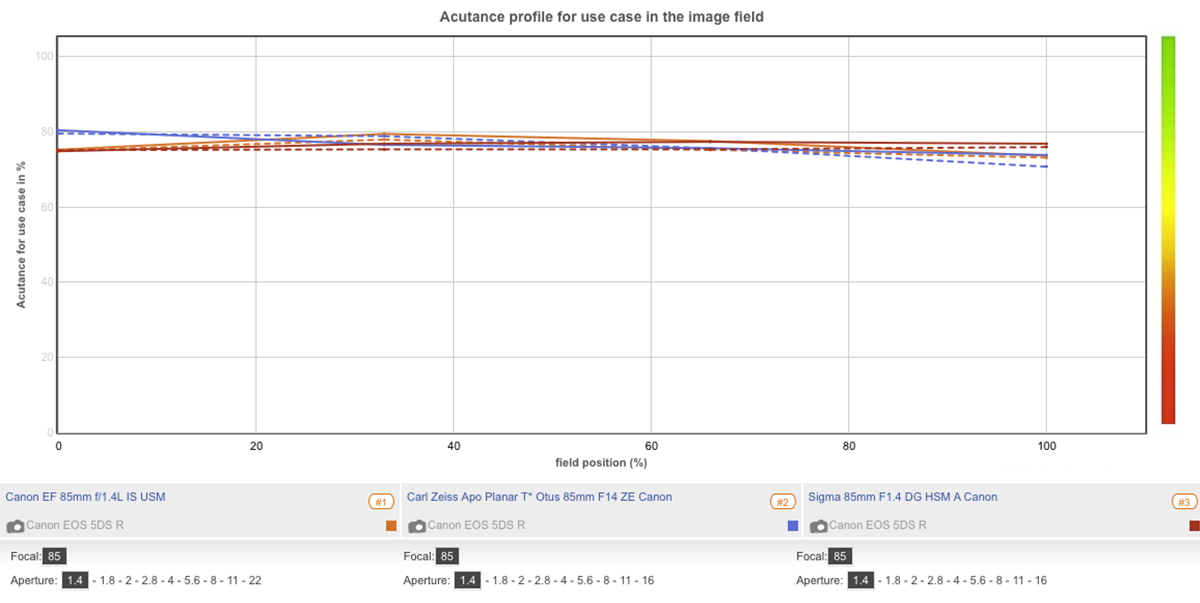
The Canon lens achieves peak sharpness at f/5.6, and it’s here that it begins to overtake the Zeiss as it’s stopped down — but again, the difference between them is so slight that you’re unlikely to notice. Even then, the Zeiss shows superb sharpness, with the lowest astigmatism of the three.
The Sigma lens is again practically identical to the Canon; however, peak sharpness goes to the Canon. Remarkably, the Sigma has the slightly lower astigmatism of the two, though as before, it’s so close that it’s unlikely you’d see the difference. All three lenses are really close.
Chromatic aberration
In lenses this fast, lateral chromatic aberration is usually most noticeable at their widest aperture. Typically it’s nonexistent in the center of the frame and increases in severity towards to the corners, appearing as colored fringing on either side of high-contrast edges in the image plane.
Although the Canon lens controls lateral chromatic aberration (LaCA) very well, it has higher levels between f/1.4 and f/2.8 than the Zeiss or even the Sigma, which just goes to show how well corrected those lenses are. Although the Canon lens has higher LaCA at those wider apertures, the colored fringing (which shows up usually as cyan and pink fringing on high-contrast edges) is still below 5µm, which we consider to be low for a fixed focal-length prime lens. To put that into some perspective, that’s around the width of a single pixel on the Canon 5DS R sensor.
From f/4 onwards, however, the Canon is the better corrected of the three, with lower LaCA across the frame. The profile above shows the width of the colored fringing occurring in all three lenses across half the image frame.
LaCA is measured from the center of the frame at the left (0% field position) to the extreme corner of the frame (at 100%) to the right. To reduce the fringing, Canon EF lenses use a correction profile which can be turned off in-camera. However, our results show the result before software correction is applied, so LaCA may be greatly reduced or even not visible at all in out-of-camera JPEGs or in RAW files processed with supported software.
Geometric distortion
Distortion isn’t typically a problem in mid-tele lenses like this, so it isn’t really surprising to see all three with relatively low levels. Indeed, the Sigma has no measurable distortion at all and even the lens with the highest distortion of the three, the Zeiss, shows a value of -0.2%, which is relatively low.
A negative value means there’s pincushion distortion, where the edges of the frame bow inwards towards the center, but even a low value of -0.2% will be noticeable if there are any straight elements in the scene that are both parallel and close to the border of the frame. A value of -0.1% for the Canon lens is better, meaning less pincushion distortion, but it’s still likely to be visible with certain subjects that are known to be straight, such as door frames or corners of walls that are both close and aligned to the edge of the image frame.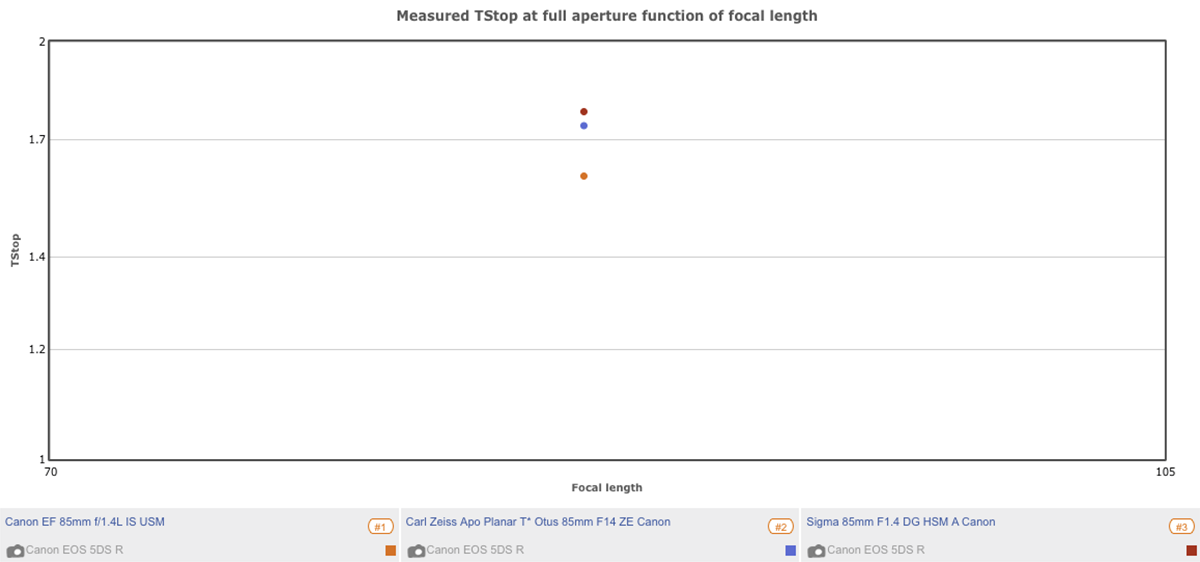
Vignetting (corner shading)
High-speed lenses like these usually exhibit more vignetting than slower lenses, and they are often used for aesthetic reasons with portraiture. Still, manufacturers go to great lengths to reduce corner shading. As the EF 85mm F1.4L IS USM is relatively compact and certainly the smallest of the three in our comparison, the Canon lens is notable for its relatively moderate vignetting at the widest aperture, measured at -1.8EV. The Zeiss also has similar levels of vignetting, but it has a much larger front element to combat the effects. To put this in perspective, the Zeiss has an 86mm filter thread against the 77mm thread on the Canon. Likewise, the Sigma also has a gigantic objective with the same size (86 mm) filter thread, but it’s even more effective at reducing vignetting, measuring corners that are +0.5EV brighter than both rivals. To put that into context, though, a 0.3EV difference is likely to go unnoticed.
As these are averaged figures, it’s also worth looking at the slope of the falloff in exposure in our vignetting profiles. A steep profile with a larger central area would likely exaggerate the corners, while a more gentle falloff won’t have the same visual weight, thus making the corners look lighter, even though they may have the same value. The field maps available using our comparison tool give a better visual representation of the effect.
Besides the visible corner shading at full aperture, the Canon and Zeiss lenses clear up quite nicely after stopping down two stops, though the Sigma needs only one stop to achieve the same effect.
Transmission
As with the other metrics, all three lenses perform exceptionally, but from our measurement data, it’s the Canon lens that edges out in front. Transmission has a direct bearing on exposure, so while the Canon lens is brighter by +0.1EV and +0.2EV over the already excellent transmission of the Zeiss (T1.7) and Sigma (T1.8), respectively, it’s more noteworthy for the small 0.2EV difference between the measured value (T1.6) and the computed f/1.4 aperture value.
Conclusion
Given Canon’s history of producing high-end, ultra-fast 85mm f/1.2 models, the introduction of the Canon EF 85mm F1.4L IS USM was a surprise. Not only did the new model have a modern design and optical stabilization, its lower price means that it was not intended to replace the F1.2 version but to sit alongside it. Perhaps more surprising, though, was that the RF mount was announced not long after.
Still, Canon’s existing DSLR user base is enormous, even if interest in the new mount has somewhat eclipsed the EF mount, and it’s not like EOS-R system cameras can’t take advantage of the exceptional performance of this EF lens. Regardless of whether you’re a DSLR user or if you’ve made the move to mirrorless, one major advantage over the EF 85mm F1.2L II USM is that the EF 85mm F1.4L USM is sharp from the center to the edges of the frame at all apertures. That’s especially important when focusing with the lens wide-open, as the main area of interest in portraits is rarely positioned dead center in the middle of the frame. Chromatic aberration is also well-controlled and the inclusion of image stabilization is a plus for wedding photographers and others who can’t always dictate their lighting. As a professional L-series lens, it isn’t cheap, of course — but then, quality like this never is.
In this review, we have compared the Canon EF 85mm F1.4L USM mounted on a Canon EOS 5DS R to its closest rivals from other brands. Remember that these lenses may be used on different camera systems using different mounts, so such comparisons are not strictly applicable.
As usual, you can create your own comparisons and in-depth analyses using our interactive image lens comparison tool.


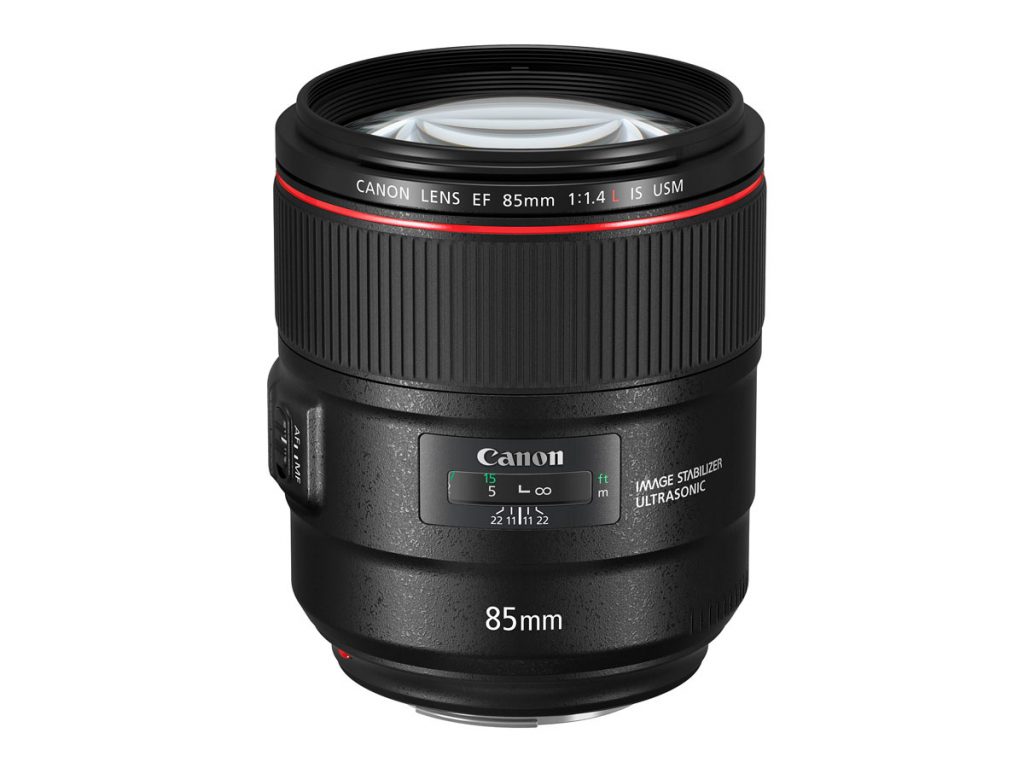


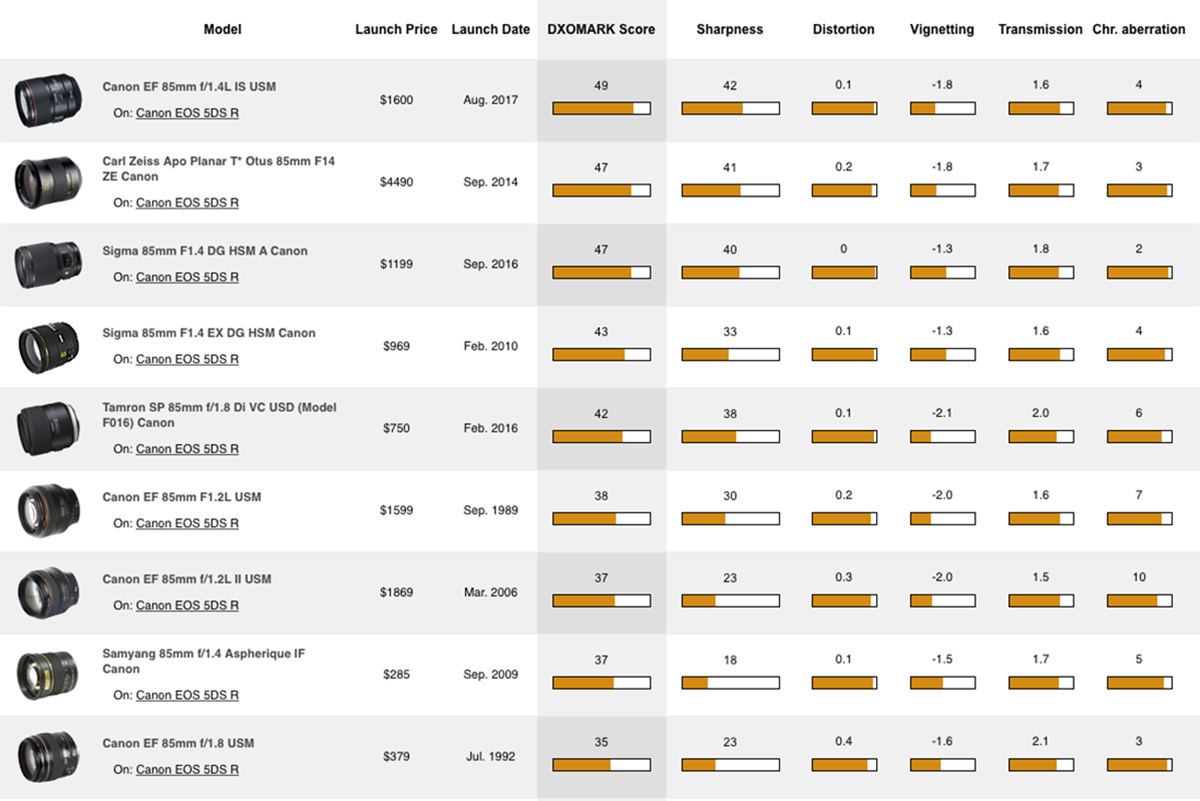
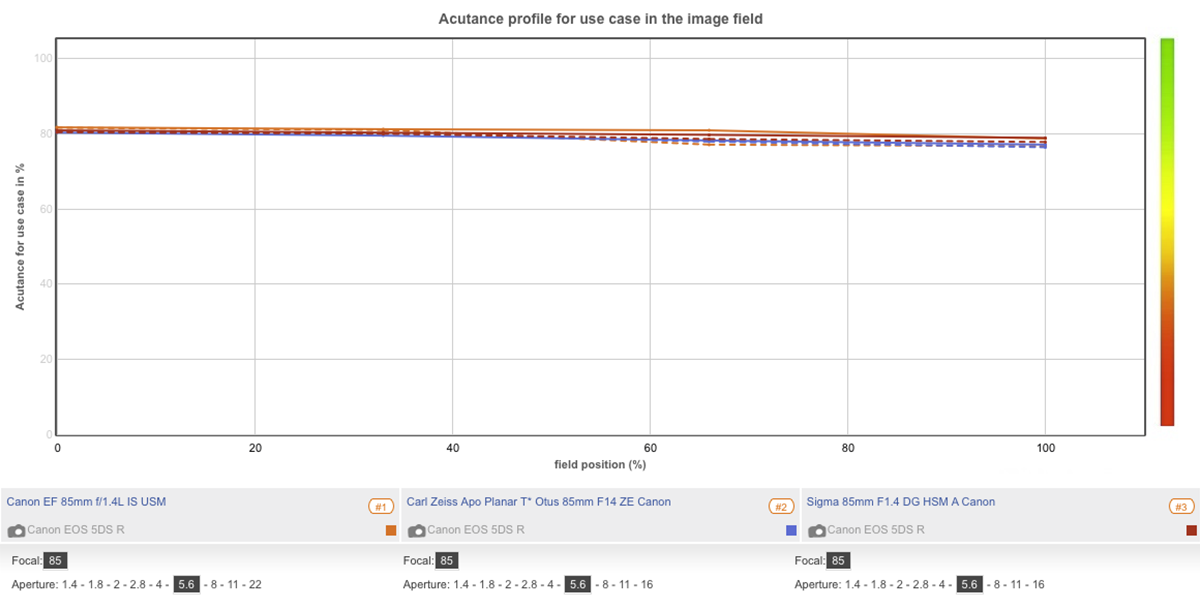
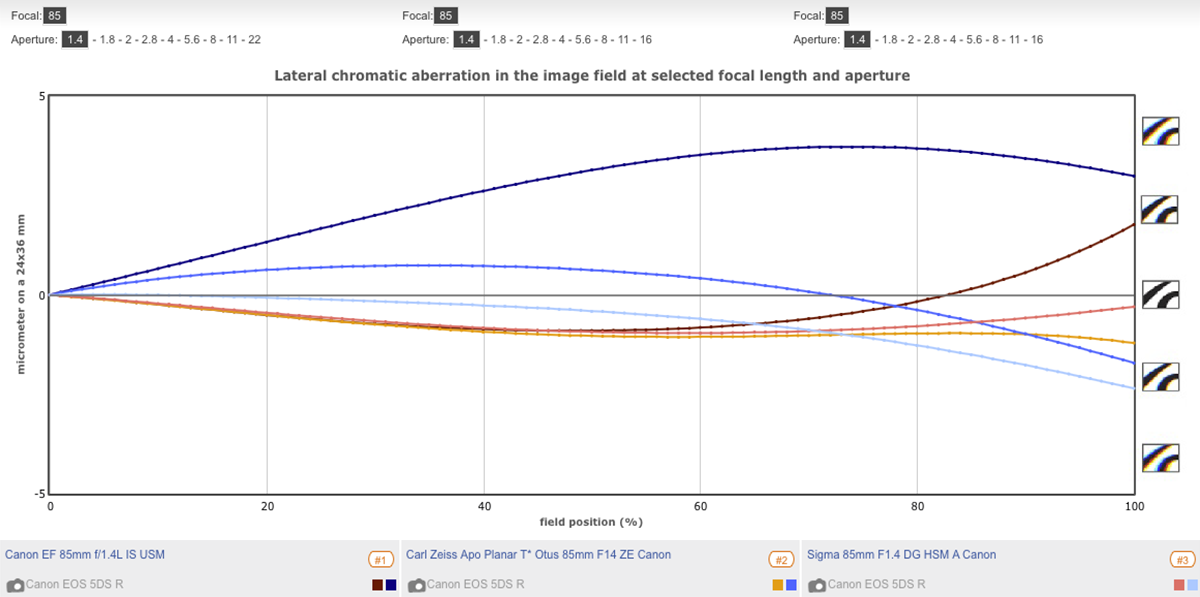
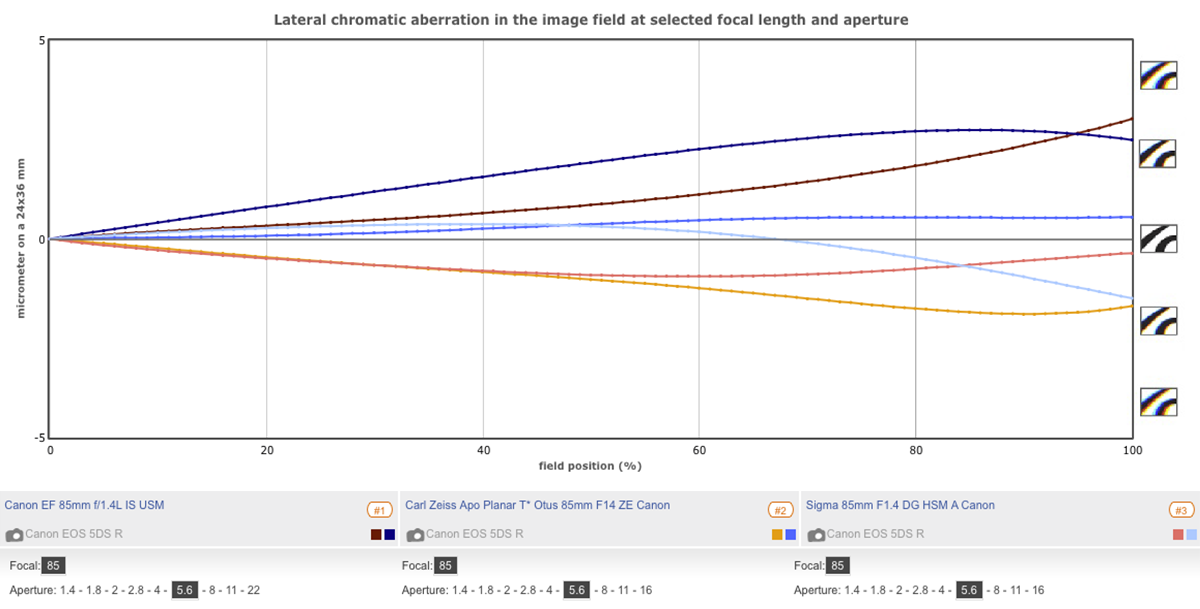
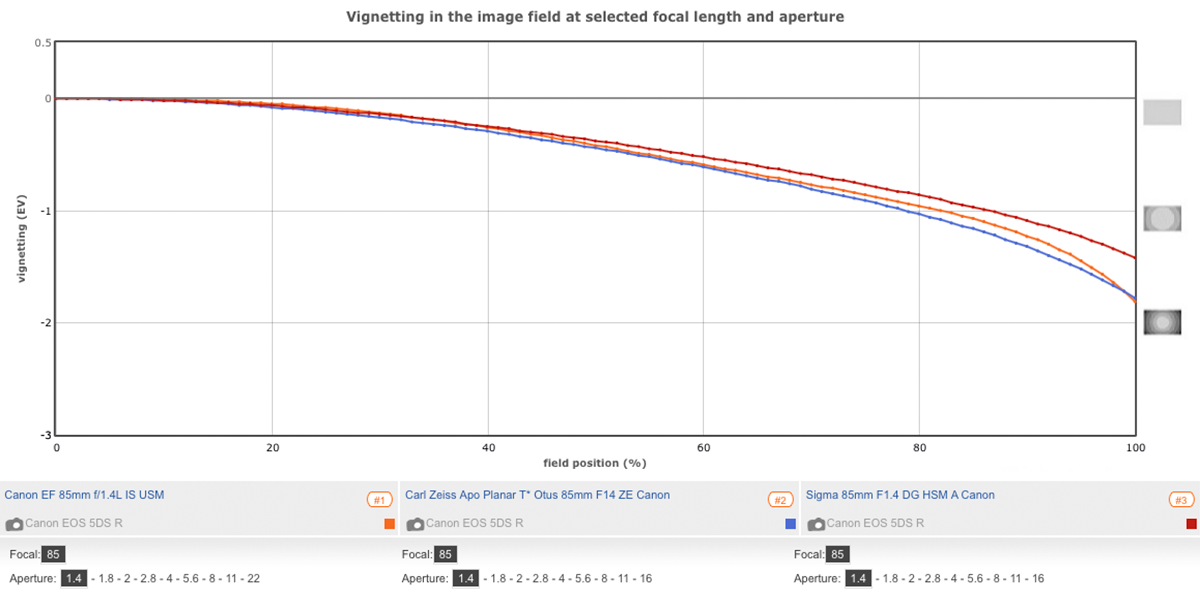
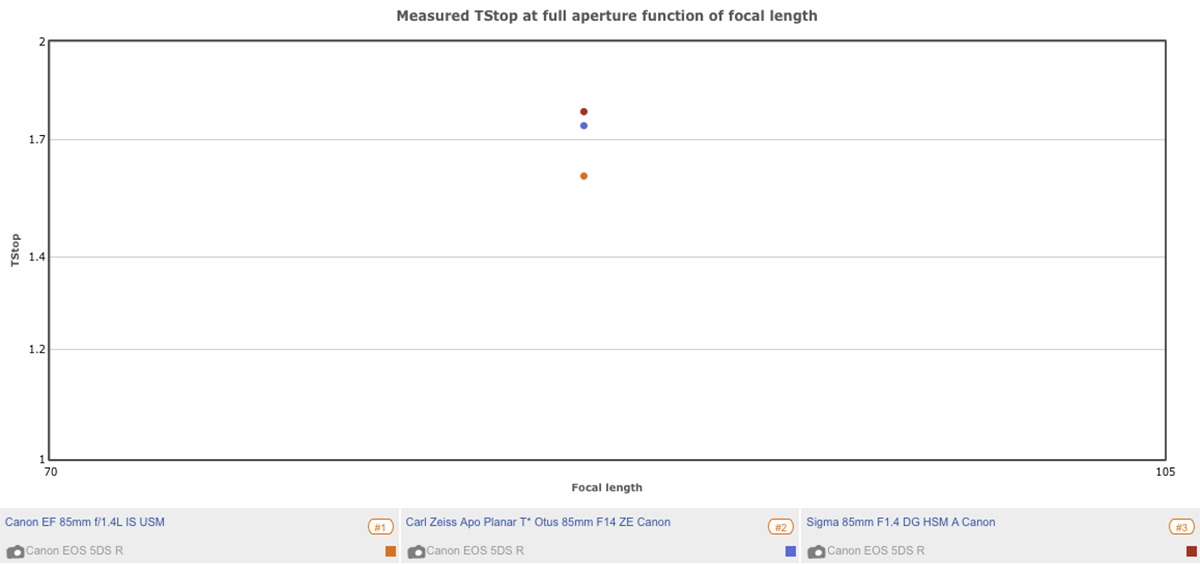
DXOMARK encourages its readers to share comments on the articles. To read or post comments, Disqus cookies are required. Change your Cookies Preferences and read more about our Comment Policy.